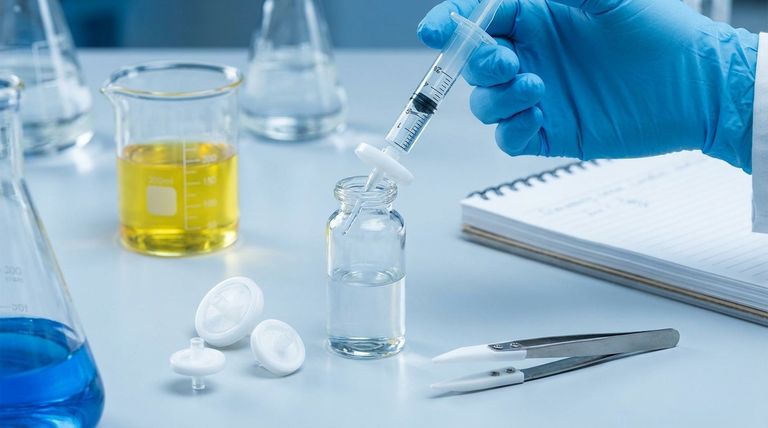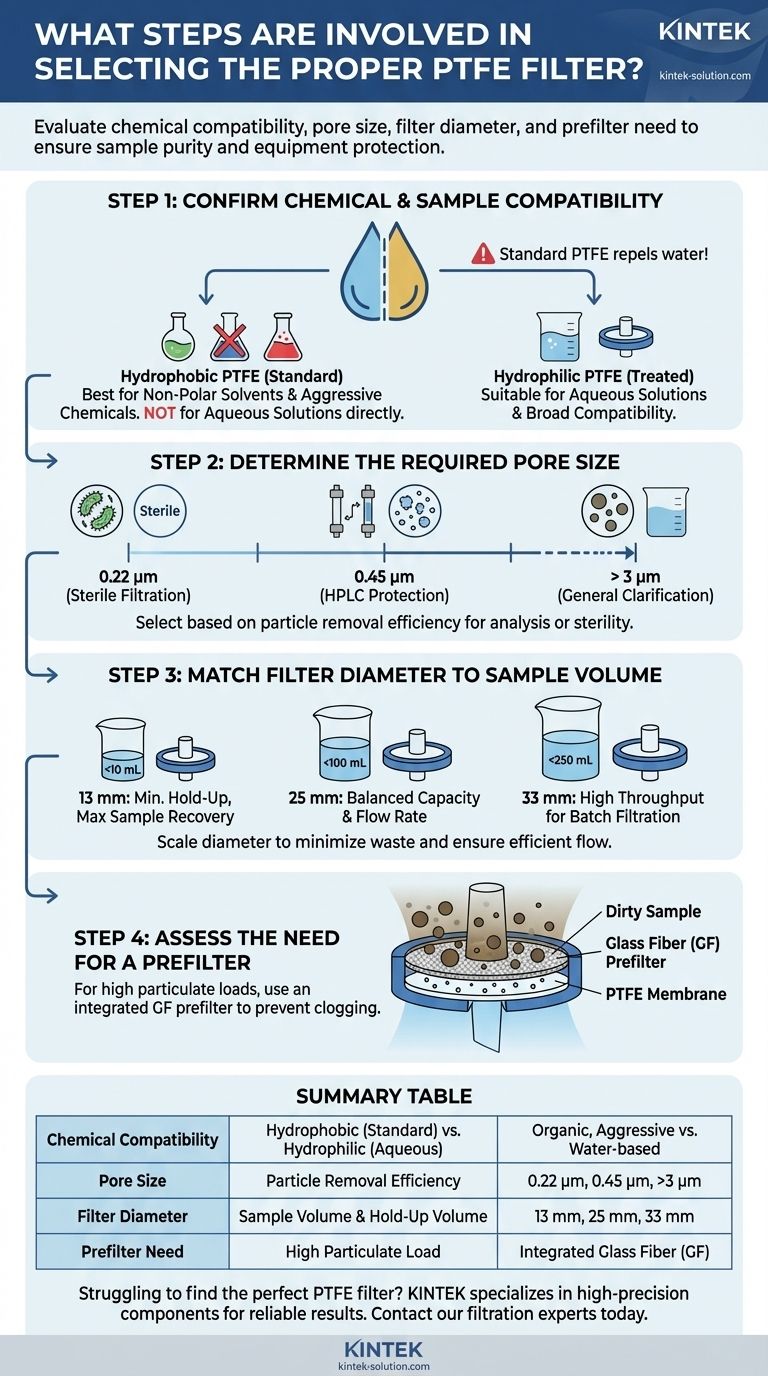To select the proper PTFE filter, you must evaluate four critical factors: the chemical compatibility of your sample with the hydrophobic PTFE membrane, the required pore size for your application (e.g., clarification vs. sterilization), the appropriate filter diameter for your sample volume, and whether the sample's particulate load necessitates a prefilter.
The core task is not just to filter a liquid, but to prepare a sample for analysis or use with maximum purity and minimal loss. A successful selection balances chemical resistance, particle removal efficiency, and sample volume to ensure your downstream results are reliable and your equipment is protected.

Understanding PTFE's Core Properties
Polytetrafluoroethylene (PTFE) is a go-to membrane material for a specific set of demanding applications. Understanding its fundamental nature is the first step in making an informed choice.
The Defining Trait: Hydrophobicity
PTFE is an inherently hydrophobic (water-repelling) material. This makes it ideal for filtering non-polar, organic solvents and aggressive chemicals that would degrade other membranes.
Exceptional Chemical Resistance
This material exhibits broad resistance to nearly all acids, bases, and aggressive solvents. It is the default choice for chemically harsh filtration tasks where other materials would fail.
The Four-Step Selection Framework
Follow this logical process to ensure you choose the correct filter for your specific task, preventing clogged filters, sample contamination, or equipment damage.
Step 1: Confirm Chemical and Sample Compatibility
While PTFE has excellent chemical resistance, its hydrophobic nature is a critical consideration.
Standard PTFE is not suitable for filtering aqueous solutions directly. Water will not pass through the membrane without extremely high pressure. For aqueous samples, you must either pre-wet the membrane with a solvent like methanol or isopropanol or, more reliably, use a specially treated hydrophilic PTFE filter.
Step 2: Determine the Required Pore Size
The filter's pore size dictates the size of the particles it removes. This is the most critical technical specification for achieving your goal.
A larger pore size (e.g., >3 µm) is used for general clarification and removing large particulates.
A smaller pore size (e.g., <3 µm) is used for fine clarification and analysis. The most common sizes are 0.45 µm for general particulate removal to protect instruments like HPLC columns, and 0.22 µm for sterile filtration.
Step 3: Match Filter Diameter to Sample Volume
The filter's diameter must be scaled to the amount of liquid you are processing to minimize waste and ensure efficient flow.
- For small volumes (<10 mL): A 13 mm diameter filter is typical to minimize sample loss (hold-up volume).
- For medium volumes (<100 mL): A 25 mm diameter filter offers a good balance of capacity and flow rate.
- For larger volumes (<250 mL): A 30 mm or 33 mm filter provides higher throughput for batch filtration.
Step 4: Assess the Need for a Prefilter
If your sample contains a high concentration of particulates, it can quickly clog the fine pores of a standard PTFE membrane.
In these cases, select a syringe filter that includes an integrated prefilter, often made of glass fiber (GF). The GF layer acts as a coarse filter, trapping larger particles and allowing the PTFE membrane to efficiently remove the finer ones, dramatically increasing the filter's capacity.
Understanding the Trade-offs
Selecting a filter is a process of balancing competing factors. Being aware of the potential downsides is crucial for avoiding common errors.
The Risk of Aqueous Sample Failure
The most common mistake is attempting to filter a water-based sample with a standard PTFE filter. This will not work and can lead to frustration, sample loss, and potentially bursting the syringe from excessive pressure. Always confirm your sample type.
Hold-Up Volume and Analyte Loss
Every filter retains a small amount of liquid after filtration, known as the hold-up volume. Using an oversized filter for a small, precious sample can lead to significant analyte loss. Always choose the smallest diameter suitable for your volume.
Extractables and Background Noise
While PTFE is a very "clean" polymer, low-quality filters can contain manufacturing residues called extractables. For sensitive analyses like HPLC or mass spectrometry, always choose filters certified as having low extractables to avoid contaminating your sample and creating background noise in your results.
Making the Right Choice for Your Goal
Use these guidelines to match a filter directly to your primary objective.
- If your primary focus is preparing organic solvents for HPLC: Use a 0.45 µm standard PTFE filter, choosing the diameter based on your sample volume.
- If your primary focus is sterilizing aggressive chemicals or solvents: Use a 0.22 µm standard PTFE filter.
- If your primary focus is filtering a high-particulate "dirty" solvent: Use a PTFE filter with an integrated glass fiber (GF) prefilter.
- If your primary focus is filtering an aqueous solution with broad chemical compatibility: You must use a hydrophilic PTFE filter.
Choosing the correct filter is the first and most critical step toward achieving clean, reliable, and reproducible results in the lab.
Summary Table:
| Selection Factor | Key Consideration | Common Options |
|---|---|---|
| Chemical Compatibility | Hydrophobic (standard) vs. Hydrophilic (aqueous) | Organic solvents, aggressive chemicals, water-based solutions |
| Pore Size | Particle removal efficiency | 0.22 µm (sterile), 0.45 µm (HPLC), >3 µm (clarification) |
| Filter Diameter | Sample volume and hold-up volume | 13 mm (<10 mL), 25 mm (<100 mL), 33 mm (<250 mL) |
| Prefilter Need | High particulate load | Integrated glass fiber (GF) prefilter |
Struggling to find the perfect PTFE filter for your demanding application?
At KINTEK, we specialize in manufacturing high-precision PTFE components, including seals, liners, and labware, for the semiconductor, medical, laboratory, and industrial sectors. Our expertise ensures you get a filter that delivers maximum purity, protects your sensitive equipment, and provides reliable, reproducible results—whether you need a standard prototype or a high-volume custom order.
Contact our filtration experts today for a consultation tailored to your specific chemical, volume, and particulate challenges.
Visual Guide

Related Products
- Custom PTFE Parts Manufacturer for Teflon Parts and PTFE Tweezers
- Custom PTFE Parts Manufacturer for Teflon Containers and Components
- Customizable PTFE Seals Filter Holders for Versatile Applications
- Custom PTFE Teflon Balls for Advanced Industrial Applications
- Custom PTFE Bottles for Diverse Industrial Applications
People Also Ask
- What factors should be considered when choosing between Nylon and PTFE? Select the Right Material for Your Application
- What are the unique properties of PTFE? Unlock Unmatched Performance in Demanding Applications
- What are the main applications of PTFE type Teflon? Unlock Its Versatility for Your Industry
- What chemical processing applications involve PTFE-machined parts? Essential Components for Corrosive & High-Purity Systems
- What challenges arise when machining PTFE (Teflon)? Overcome Softness, Heat, and Instability



















